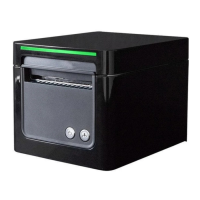Defines the user-defined character pattern for the specified character codes.
• y specifies the number of bytes in the vertical direction.
• c1 specifies the beginning character code for the definition, and c2 specifies the final
code.
• x specifies the number of dots in the horizontal direction from the left.
• d specifies the defined data (column format).
• k indicates the number of defined data. k is an explanation parameter; therefore it
does not need to be transmitted.
■ Character codes from the alphanumeric characters in Hexadecimal: 20H to 7EH / in
Decinal: 32 to 126 can be defined.
■ Data (d) specifies a bit printed to 1 and not printed to 0. The dot pattern is in the
horizontal direction from the left side. Any remaining dots on the right side are blank.
■ The data to define a user-defined character is (y × x) bytes.
■ When the value of y, c1, c2, or x is out of the range, this command is canceled, and
the following data is processed as normal data.
■ This command can define user-defined characters for each font independently. To
select a font, use ESC ! or ESC M.
■ A user-defined character, downloaded graphics, and downloaded bit image cannot
be defined simultaneously on some printer models.
• When this command is executed, the downloaded bit image is cleared.
• When GS ( L <Function 83> <Function 84> or GS ✻ is executed, the user-defined
character data is cleared.
■ Once the user-defined characters have been defined, they are available until ESC ?,
GS ✻, or ESC @ is executed; the user-defined characters are redefined; the power is
turned off; or the printer is reset.
■ The user-defined characters are not defined at the default, and the resident
characters are printed.
■ The relationship between the definition data and printing result is as follows.
Example: Downloaded character definition consists of 9 × 7 dots.

